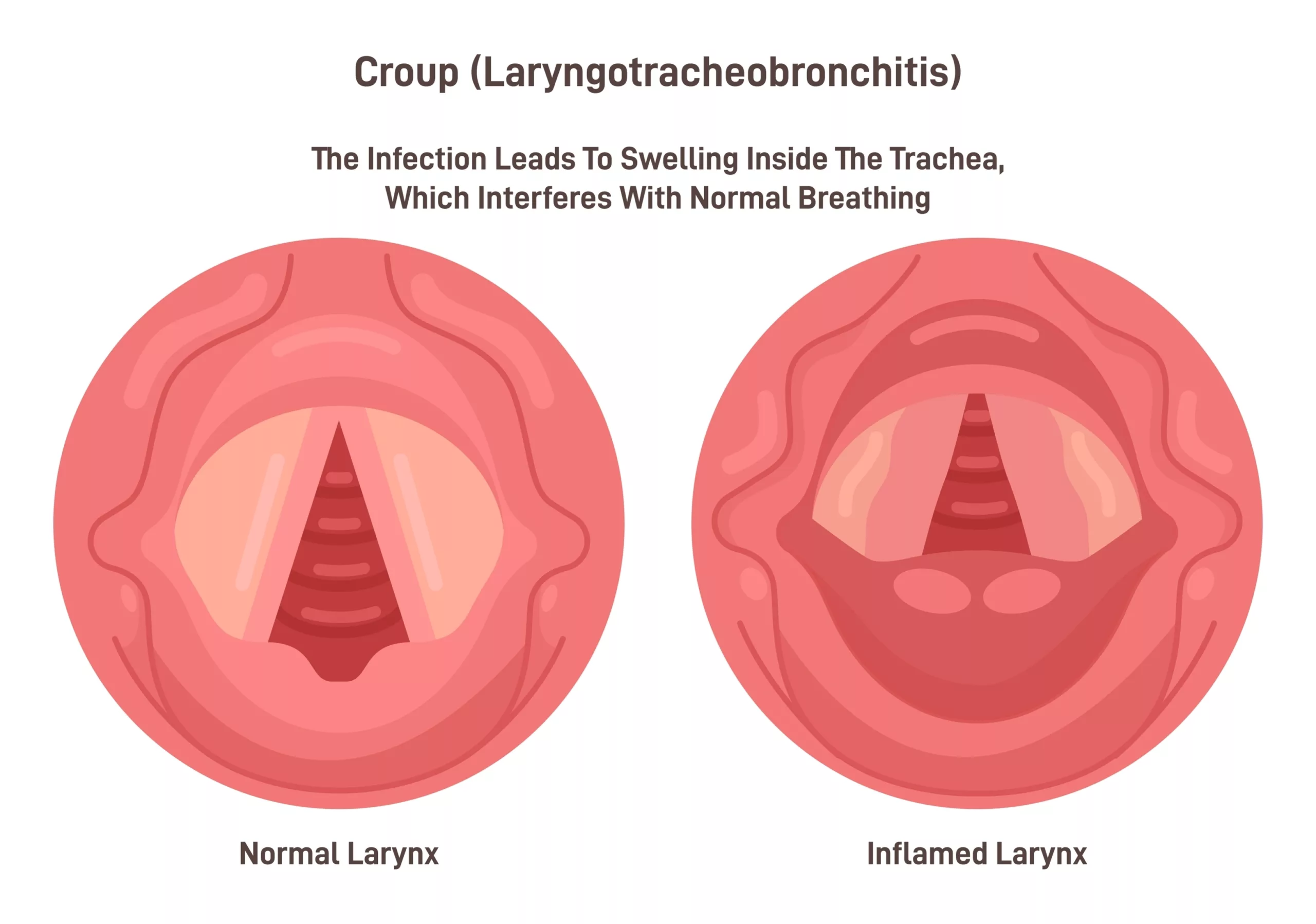Croup, also referred to as viral laryngotracheitis, is a highly contagious upper respiratory tract illness that mainly affects infants and young children, particularly between 6 months and 3 years of age. Most of the time, an underlying parainfluenza virus is the cause of a barking cough. The viral infection causes swelling and irritation of multiple respiratory structures, including the voice box (larynx), bronchial tubes, and the windpipe (trachea). As air passes through the swollen upper airway, it produces the classic seal-like barking sound and raspy breathing that define the condition. In most cases, viral croup is self-limiting, with symptoms resolving within three days. However, the severity can range from mild to life-threatening, particularly in cases where airway obstruction progresses rapidly and requires urgent medical intervention.
In a study, the prevalence of croup in children (under 5 years) was found to be 35.9%.1 Nejashmikj, V. R. (2024). Croup in Children and Risk Factors. Contributions/Prilozi (1857-9345), 45(3). However, another newer study found the prevalence to be 3% in kids aged 6 months to 3 years.2Sheikh, M. H., Albalawi, H. J. M., Albalawi, Y. A. S., Alotaibi, M. A. R., Alsharef, S. M. M., Alshehri, A. A. A., … & Alomrani, H. H. H. (2021). Updates in Diagnosis and Management of Croup. Journal of Pharmaceutical Research International, 33(49), 294-300.

Types of Croup
Croup isn’t a single condition but rather a group of related respiratory illnesses that share similar symptoms like a barking cough, hoarseness, and stridor. Here are the main types:
Viral Croup (Classic Croup):
This is the most common form and usually affects children between 6 months and 3 years of age. It’s caused by respiratory viruses — especially the parainfluenza virus — and is typically accompanied by cold-like symptoms such as nasal congestion and mild fever. Symptoms develop gradually and usually resolve within a few days with supportive care.
Spasmodic Croup:
This type tends to appear suddenly, most often at night, and without warning symptoms like fever or runny nose. The child may go to bed perfectly fine and wake up with a harsh, barking cough and stridor. Episodes often resolve quickly and can recur over several nights. It’s more common in children with a family history of allergies and is sometimes called “allergic croup.”
Recurrent or Atypical Croup:
When a child experiences repeated episodes of croup without signs of viral infection, it may be classified as recurrent or atypical croup. This pattern can signal underlying conditions such as airway anomalies, reflux disease, or even allergic triggers. These cases often require further evaluation by a healthcare professional to determine the cause.
Other Related Conditions
The following conditions are related to croup, but we consider these distinct clinical entities:
Laryngitis
Laryngitis is an inflammation confined to the larynx and mainly presents with hoarseness. It commonly affects older children and adults and, like croup, is usually viral in origin.
Laryngotracheobronchitis
This condition occurs when the inflammation seen in the croup spreads deeper into the bronchi. It may cause additional symptoms such as wheezing or crackles in the lungs and tends to be more severe than laryngotracheitis alone.

Bacterial Tracheitis
Sometimes referred to as bacterial croup, this is a serious bacterial infection of the trachea and surrounding tissues. It can arise as a complication of viral croup and usually presents with high fever, toxic appearance, and worsening respiratory distress after an initial mild illness. It requires urgent medical treatment.
Croup Symptoms
The symptoms generally last 3 to 7 days. For most people, the initial symptom is a runny nose, and a barking cough develops a couple of days later.
In most cases, patients report the following symptoms:
Loud Cough:
A loud barking cough is a hallmark of the disorder. Clinicians identify the syndrome based on the characteristic seal-like barking cough.3Sharan, R. V., Abeyratne, U. R., Swarnkar, V. R., & Porter, P. (2018). Automatic croup diagnosis using cough sound recognition. IEEE Transactions on Biomedical Engineering, 66(2), 485-495.
Voice Hoarseness :
Several patients experience hoarseness of the voice, which can be attributed to the irritation and swelling of the voice box (laryngitis).
Fever:
This common childhood respiratory tract disorder also presents with pyrexia (fever). Generally, fever is seen with respiratory symptoms like coughing and breathing difficulties.4Peate, I. (2022). Croup—a common childhood upper respiratory tract disease. British Journal of Healthcare Assistants, 16(4), 178-183.
Labored Breathing:
Narrowing of the air passages and associated structures causes significant difficulties in breathing. The difficulty is accompanied by a production of rasping (rough/unpleasant) sounds in breathing. Patients frequently have labored breathing, which may present with a stridor (noisy, raspy sounds during breathing). According to studies, stridor is seen in mild croup, while labored breathing is common in moderate-to-severe croup cases.5Petrocheilou, A., Tanou, K., Kalampouka, E., Malakasioti, G., Giannios, C., & Kaditis, A. G. (2014). Viral croup: diagnosis and a treatment algorithm. Pediatric pulmonology, 49(5), 421-429.
Other less common symptoms include:
- Lymph node swelling
- Cyanosis, i.e., bluing of skin due to severe respiratory blockage
- Restlessness, confusion, and fatigue
Causes of Croup
The most prevalent cause of a barking cough is a viral infection. Different classes of viruses can lead to croup, including:
- Influenza virus
- Parainfluenza virus
- Respiratory syncytial virus (RSV)
- Adenovirus
- Measles infection
- Rhinovirus
However, the most common pathogen is the parainfluenza virus. Modern studies show that SARS-CoV-2 infection (COVID-19) can also cause croup syndrome, but the management strategies for COVID-19 infection are different from those for common viral infections.6Tsoi, K., Chan, K. C., Chan, L., Mok, G., Li, A. M., & Lam, H. S. (2021). A child with SARS‐CoV2‐induced croup. Pediatric pulmonology, 56(7), 2377.
Is Croup Contagious?
If croup arises due to an underlying viral infection (mainly parainfluenza), it is a contagious disease as these respiratory viruses are transmissible. Thus, you should abstain from your child interacting (in school, playground, etc.) with other kids for at least 24 hours after the symptoms (fever) have subsided.
Croup Diagnosis
In most cases, the child’s history is sufficient to reach a diagnosis. Your healthcare provider will take a complete history of the signs and symptoms, like stridor and barking cough, etc.
A physical examination follows next. Your doctor will listen to the child’s breath by placing a stethoscope on the chest. Most physicians look for signs of wheezing in the breath.
Very rarely, doctors order neck X-rays to rule out other similar conditions like foreign body lodgement or epiglottitis. In affected patients, neck X-rays reveal a typical narrowing of the vocal cords known as the steeple sign.7Hoyt, K. S., & Shea, S. S. (2015). Steeple Sign: A Case of Croup. Advanced Emergency Nursing Journal, 37(2), 79-82.
Differential Diagnosis:
Croup Vs Whooping Cough
Like croup, whooping cough is a respiratory condition of the young (infants and small children). While both present with symptoms of cough and breathing issues, the cough seen in whooping cough is more of a high-pitched sound that resembles gasping for air. Unlike croup, whooping cough develops as a result of a bacterial infection, and it can be treated with antibiotics. You can get vaccines for whooping cough (but not for croup syndrome). Moreover, the duration of the disease for the bacterial infection is longer than for croup.
When Does Croup Need Immediate Medical Attention?
Your child’s barking cough may become a serious issue. You must seek immediate medical attention if your child is facing the following symptoms:
Breathing difficulties with Retractions:
Retractions are a condition in which the skin pulls around the ribs or the neck as the patient breathes. This indicates a serious breathing issue. Stridor and rapid breathing may accompany retractions.
High-grade Fever:
If the fever does not improve with medications, you must visit the ER.
Cyanosis:
You should rush to a hospital if the breathing trouble is accompanied by cyanosis (turning blue) of the fingernails or lips. This shifting to the blue-gray coloration of the skin/lips is indicative of low oxygen levels.
Croup Treatment
Your body produces antibodies against pathogenic viruses. Once the antibodies outnumber the viruses in combat, symptoms resolve. In many mild cases, doctors do not prescribe medications but instead recommend general supportive care while monitoring for signs of worsening symptoms. Clinical data shows that over 80% of croup cases are mild and recover without the need for intensive treatment.
Supportive Care for Mild Croup:
For children with mild croup, supportive care can help ease discomfort and aid recovery
- Keep your child hydrated. Use warm fluids to loosen the mucus and reduce vocal inflammation.
- Provide cool, fresh air. You can do this by opening the room windows (only if the outside air is clean and unpolluted).
- Use OTC medications like paracetamol and acetaminophen for fever management.
- Keep your child’s head slightly elevated while sleeping, as narrowing of the passage can pose breathing difficulties during sleep.
Management For Moderate Croup:
For mild-to-moderate cases, doctors at the ER manage patients in the following ways:
- Give oxygen (or humidified air to ease breathing).
- Administer isotonic fluids (crystalloids, etc.) via IV line to counter dehydration.
- Your child may need emergency medications like glucocorticoids (steroids) in the form of single-dose oral dexamethasone/prednisolone (rarely doctors opt for intramuscular or intravenous routes). Steroid administration quickly reduces swelling and clears the airways.
- Nebulized epinephrine also helps reduce airway swelling (within 10 minutes).8Johnson, D. W. (2014). Croup. BMJ Clinical Evidence, 2014, 0321.
Medical staff monitors the child’s vitals, like oxygen saturation, heart rate, breathing rate, etc. Very rarely, doctors need to insert an endotracheal tube for mechanical ventilation. This occurs only in cases with severe airway blockage.
Note: Parents should stay vigilant regarding the condition of their child and rush to the hospital if the child suffers from serious breathing obstructions.
Wrapping Up
Croup syndrome is a common respiratory infection in kids that causes a seal-like barking cough. Mostly caused by the parainfluenza virus, it is generally a mild disease that is highly contagious. Patients experience fever, barking cough, labored breathing, and hoarseness due to inflammation of the bronchioles and the voice box. Mild croup goes away without treatment (and with the help of home remedies). Moderate-to-severe croup syndrome requires medical attention, for which doctors give oxygen, steroids, and nebulized epinephrine. Symptoms like fatigue, cyanosis, and stridor with retractions require immediate medical treatment. Thus, parents should immediately take the child to the ER as it may become a life-threatening condition.
Refrences
- 1Nejashmikj, V. R. (2024). Croup in Children and Risk Factors. Contributions/Prilozi (1857-9345), 45(3).
- 2Sheikh, M. H., Albalawi, H. J. M., Albalawi, Y. A. S., Alotaibi, M. A. R., Alsharef, S. M. M., Alshehri, A. A. A., … & Alomrani, H. H. H. (2021). Updates in Diagnosis and Management of Croup. Journal of Pharmaceutical Research International, 33(49), 294-300.
- 3Sharan, R. V., Abeyratne, U. R., Swarnkar, V. R., & Porter, P. (2018). Automatic croup diagnosis using cough sound recognition. IEEE Transactions on Biomedical Engineering, 66(2), 485-495.
- 4Peate, I. (2022). Croup—a common childhood upper respiratory tract disease. British Journal of Healthcare Assistants, 16(4), 178-183.
- 5Petrocheilou, A., Tanou, K., Kalampouka, E., Malakasioti, G., Giannios, C., & Kaditis, A. G. (2014). Viral croup: diagnosis and a treatment algorithm. Pediatric pulmonology, 49(5), 421-429.
- 6Tsoi, K., Chan, K. C., Chan, L., Mok, G., Li, A. M., & Lam, H. S. (2021). A child with SARS‐CoV2‐induced croup. Pediatric pulmonology, 56(7), 2377.
- 7Hoyt, K. S., & Shea, S. S. (2015). Steeple Sign: A Case of Croup. Advanced Emergency Nursing Journal, 37(2), 79-82.
- 8Johnson, D. W. (2014). Croup. BMJ Clinical Evidence, 2014, 0321.

